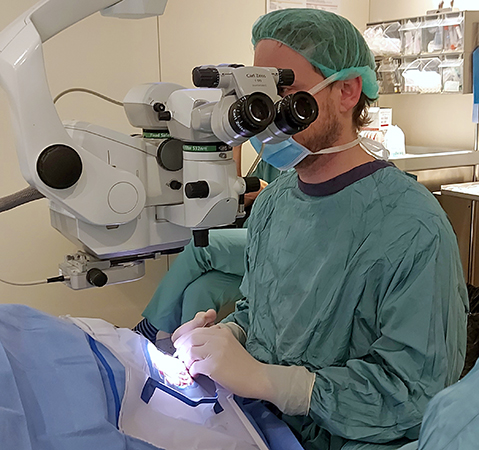The goal of glaucoma surgery is to reduce intraocular pressure by draining the aqueous humor. The purpose of this reduction is to slow the progression of the disease and prevent vision from continuing to deteriorate.
Surgery is considered when pharmacological treatment or SLT laser therapy has not sufficiently reduced the pressure to halt disease progression.
Surgery is also considered when adverse effects arise from topical treatment, making it poorly tolerated, or when the patient has difficulty adhering to treatment.
In exceptional cases, surgery may be indicated in patients diagnosed when the disease is already at an advanced stage and vision is severely impaired.
At the Institut de la Màcula we select the most appropriate surgical technique depending on the patient’s characteristics and the stage of glaucoma progression.
Non-penetrating deep sclerectomy
Non-penetrating glaucoma surgeries were first described in the early 1970s. The objective was to reduce intraocular pressure and thus avoid some of the complications of standard trabeculectomy.
Non-penetrating deep sclerectomy is a drainage surgery to lower intraocular pressure. It consists of facilitating the outflow of aqueous humor from the anterior chamber of the eye to the subconjunctival space without perforating the anterior chamber.
A superficial scleral flap and a deep scleral dissection are performed underneath, leaving only a thin layer of sclera and Descemet’s membrane. To perform it, it is essential that the iridocorneal angle be open. This achieves a more physiological reduction of intraocular pressure.
It is a less invasive and very effective surgery, but it is technically more difficult than trabeculectomy.
Trabeculectomy
This is the oldest filtering surgery, but it is still used today. It consists of creating a fistula that connects the anterior chamber of the eye with the subconjunctival space. In this space, a filtering bleb forms through which aqueous humor diffuses, thereby reducing intraocular pressure.
This technique can be performed in patients with either open-angle or closed-angle glaucoma.
This surgery carries a higher risk of hypotony, which is why today non-penetrating deep sclerectomy is preferred, as it is a much simpler technique when indicated.
Implantation of aqueous humor drainage devices or valves
This type of glaucoma surgery involves inserting a device or valve that connects the intraocular space, via a tube, with the subconjunctival space, with a reservoir or plate.
Several types of devices have been developed to improve filtration, allowing aqueous humor to be diverted to the equatorial subconjunctival space.
Valves or drainage devices currently used usually consist of a tube placed in the anterior chamber, in the ciliary sulcus, or through the vitreous cavity if the patient has undergone vitrectomy. Aqueous humor flows through this device into an extraocular reservoir placed in the equatorial region over the sclera.
These devices are generally reserved for complicated cases of glaucoma where conventional filtering surgery has failed or is likely to fail, or in cases where it cannot be performed because the condition of the conjunctiva or the angle does not allow it.
Cataract surgery or combined glaucoma and cataract surgery
Cataract surgery can be an option for the treatment of narrow-angle glaucoma, since replacing the crystalline lens with an intraocular lens enlarges the iridocorneal angle.
Combined surgery is used in patients with both cataract and glaucoma. Both procedures are performed in the same surgical session, so the patient only has to undergo surgery once.
In patients with narrow angles, non-penetrating deep sclerectomy can be performed as long as it is combined with cataract surgery.
MIGS techniques
MIGS (Minimally Invasive Glaucoma Surgery) techniques are minimally invasive surgical procedures aimed at reducing intraocular pressure. They encompass a wide variety of approaches, among which we can highlight the XEN microimplant (which conducts aqueous humor from the anterior chamber to the subconjunctival space) or the iStent microimplant (which facilitates the outflow of aqueous humor through Schlemm’s canal).
Currently, the XEN microimplant stands out for providing a reduction in IOP equal to or greater than non-penetrating deep sclerectomy or trabeculectomy, with a much shorter surgical time and a lower rate of postoperative complications.


